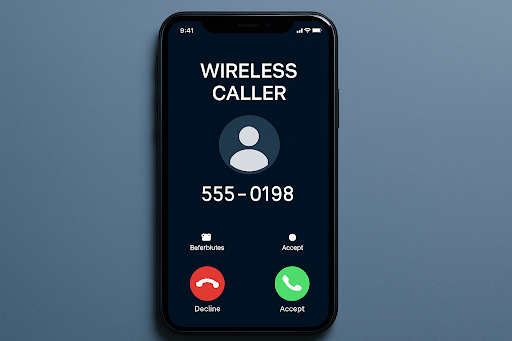
If you’ve ever looked at your phone and wondered, “What does Wireless Caller mean?”, you’re not alone. This label appears frequently on incoming calls and can be confusing, especially when no name or number is shown. In this guide, we’ll define what a wireless caller is, why this message shows up, and what you can do when it appears.
Let’s break down the meaning, differences between related terms, and steps to handle wireless calls effectively.
What Does “Wireless Caller” Mean?
The term “Wireless Caller” typically appears on your caller ID when someone is calling you from a mobile phone (cell phone), but their name or other identifying details are unavailable. It simply indicates that the call is coming from a wireless network—not a landline or VoIP service.
This label is most commonly used when:
- The caller’s name is not stored in your phone contacts
- The mobile carrier doesn’t transmit the caller’s name
- The caller has caller ID blocking enabled
In essence, “wireless caller” is a generic ID placeholder used by telecom carriers when specific details are missing.
Why Does “Wireless Caller” Show Up?
Seeing “wireless caller” on your screen may result from a combination of factors:
1. Caller ID Privacy Settings
Some individuals choose to hide their name or number for privacy. If the caller is using a mobile phone and has disabled caller ID, you’ll see “wireless caller” instead of a name.
2. Carrier Limitations
Not all carriers transmit full caller ID information. Some networks only pass along the phone number, not the caller’s name—especially when the number is not in your region or is unlisted.
3. Contact Not Saved
If you haven’t saved the number in your contacts, your phone may simply label it as “wireless caller” because it knows it’s a mobile call but has no further detail.
Wireless Caller vs. Unknown Caller vs. Private Number
These labels are often confused, but they have different meanings:
| Label | What It Means |
|---|---|
| Wireless Caller | A mobile number calling without a name attached |
| Unknown Caller | Number not recognized by the system or blocked |
| Private Number | Caller has actively hidden both name and number |
| No Caller ID | Complete anonymity, often manually blocked by the caller |
Understanding the difference helps you assess whether to answer or ignore the call.
Is a Wireless Caller a Spam or Scam?
Not always. A wireless caller could be:
- A legitimate person whose details aren’t showing
- A business using mobile lines
- A scammer using number spoofing
Because scammers often disguise their numbers, it’s wise to be cautious. If the call feels suspicious, do not answer or let it go to voicemail.
LSI keywords: spam calls, scam detection, robocalls, spoofed numbers
How to Identify a Wireless Caller
1. Reverse Phone Lookup
Use tools like:
- Truecaller
- Whitepages
- Hiya
- NumLookup
These services can reveal information about the number such as owner name, location, and carrier.
2. Google the Number
A simple web search can tell you if a number is linked to spam, a business, or an individual.
3. Call Back Safely
If you’re unsure, call the number back from a secondary line or block your own caller ID using 141 in the UK or *67 in the US.
Can You Block Wireless Callers?
Yes, and it’s simple.
iPhone:
- Open the Phone app
- Tap Recents
- Click the “i” next to the number
- Select Block this Caller
Android:
- Go to Phone > Recents
- Tap the number
- Choose Block or Report Spam
Carrier-Level Blocking:
Many providers offer spam filtering or call-blocking services (e.g., Verizon Call Filter, AT&T ActiveArmor).
Apps like RoboKiller, Hiya, or Truecaller also allow automatic blocking of suspicious numbers.
Why Do Businesses Show as Wireless Caller?
Sometimes, small businesses or individuals using work cell phones may appear as wireless callers. If they haven’t registered their number with a business name in the caller ID system, the call will appear generically.
For professionals, using a caller ID registration service like CNAM can ensure your name displays correctly.
Protecting Yourself from Unwanted Wireless Calls
Here are smart ways to avoid unwanted wireless calls:
- Use call-blocking apps
- Register your number with the UK’s TPS (Telephone Preference Service) or the US Do Not Call Registry
- Avoid answering unknown numbers
- Report repeated spam calls to your telecom provider or relevant authority
FAQs About Wireless Callers
Q: Is a wireless caller always a mobile number?
A: Yes, it refers to a call made from a cellular (mobile) phone.
Q: Why can’t I see their name?
A: Either their carrier didn’t send it or they chose to hide it.
Q: Can I stop wireless callers from reaching me?
A: You can block them individually or use third-party apps to filter unknown calls.
Q: Is it safe to answer a wireless caller?
A: Not always. Let it go to voicemail if you’re unsure, or verify the number first.
Conclusion
So, what does Wireless Caller mean? It’s simply a label used by mobile networks when a call comes from a mobile phone without a name or ID attached. While often harmless, it’s important to stay cautious—especially with the rise in spam and robocalls.
Understanding the difference between wireless caller, unknown caller, and private number helps you manage your calls more safely and avoid unwanted interruptions. Use call blockers, reverse lookup tools, and carrier filters to take control of your incoming calls and protect your privacy.


